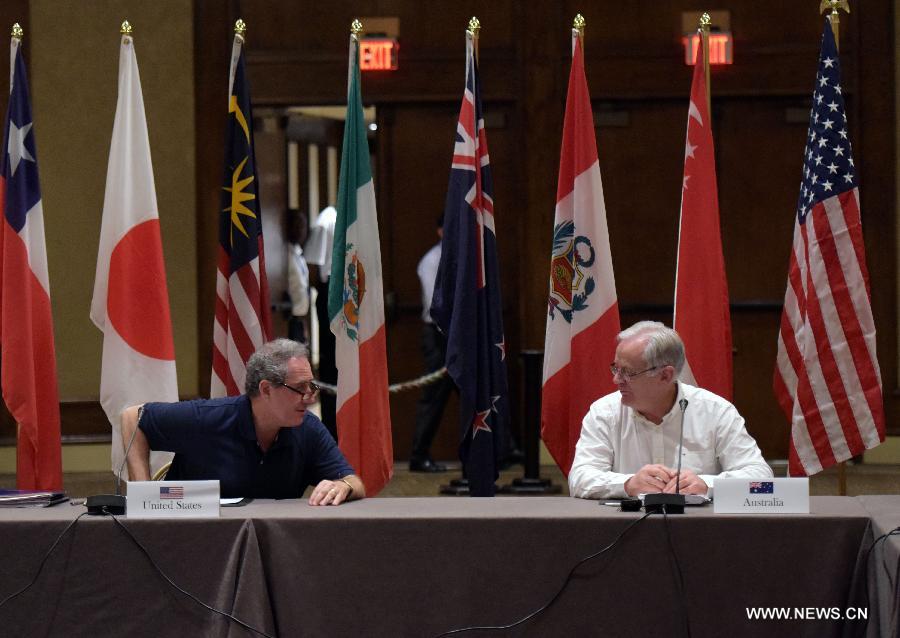The Trans-Pacific divisions
- By Dan Steinbock
 0 Comment(s)
0 Comment(s) Print
Print E-mail China.org.cn, August 7, 2015
E-mail China.org.cn, August 7, 2015
|
|
|
U.S. Trade Representative Michael Froman (R) and Australia's Trade and Investment Minister Andrew Robb attend a new round of Trans-Pacific Partnership (TPP) ministerial meetings in Maui of Hawaii, the United States, July 28, 2015. The TPP meetings kicked off here on Tuesday, with key obstacles remaining in the areas of market access and intellectual property to finalize the ambitious Asia-Pacific trade deal. [Xinhua/Yin Bogu] |
Last week, Pacific Rim officials met on the island of Maui, Hawaii, to conclude the Trans-Pacific Partnership (TPP) agreement. In addition to trade ministers from 12 countries, the meeting included 650 officials, lobby groups and other stakeholders.
But the talks failed.
Divisions behind a “one-size-fits-all” deal
According to Mexican Trade Minister Ildefonso Guajardo, the final deal was predicated on success in few but highly contested issues.
Domestically, the Obama administration is committed to quality but affordable healthcare. In the TPP sphere, it cooperates with the big pharma, even though the deal provisions threaten drug access and affordability. Washington and U.S. drug makers insist on long 12-year monopoly periods, whereas Australia and other countries push for 5-year periods to avoid high costs. No deal was reached on exclusivity periods for next-generation drugs.
Washington and Tokyo clashed over the rules of origin for cars. Since value chains extend across multiple markets, U.S. and Japan need a buy-in from Canada and Mexico, which play a central role in the U.S. car industry, while Japanese carmakers source parts from non-TPP Thailand. Strict rules would disrupt these supply chains.
The trade ministers were also divided over farm exports, while U.S. legislators warned against the exclusion of tobacco from rules allowing foreign companies to sue a host government. Despite support by U.S. beverage companies and confectioners, Australia’s effort to export more sugar to America met with U.S. cane growers’ vocal opposition, while Mexico was struggling to protect its preferential access to the U.S. sugar market.
Interestingly, some of the most controversial aspects of the proposed TPP agreement – including negotiation secrecy, income equality, investor-state arbitration (ISDS) clauses, extension of U.S. views on cyber security standards and “currency manipulation” – were barely mentioned amid the friction.
Indeed, the disagreements in Maui do not suggest traditional horse-trading that’s typical to all trade bargaining. Rather, the divisions reflect extensive disagreements not only between a dozen TPP countries, but within the U.S. itself.
Geopolitics, not free trade
In the White House, the TPP agreement has been seen as a linchpin of the administration’s pivot to Asia, which seeks to embed the U.S. more deeply in the world’s most dynamic region, while preventing a “regional vacuum” to be filled by the emerging China. The problem is that the first objective is undermined by the second.
Yet, it is impossible to achieve truly inclusive free trade in Asia Pacific as long as the region remains subject to divisive containment policies that rely on exclusive preferential trade.
Like the old European colonial powers, the U.S. has a historical presence in the region. After de-colonization, Europe’s strategic interests have diminished in Asia Pacific, whereas America’s military interests persist and are about to be amplified as the Pentagon is shifting the bulk of its naval assets to the region by 2020, while increasing military exercises and ties in the region.
During the Obama era, the administration has also strengthened political and security alliances with Japan, South Korea, and the Philippines.
Indirectly, these strategic moves have led to the relaxation of the arms embargo on Vietnam, elevated attention to the South China Sea, expansion of counterterrorist cooperation with Indonesia and the upgrade of Malaysia’s human trafficking score before the Maui Summit. The same goes for Washington’s normalization of relations with Myanmar, a pivotal nation at the crossroads of South, East and Southeast Asia.
And yet, the region has experienced increasing assertiveness, more friction in the South China Sea, an increase in terrorist efforts, continued human trafficking, division and refugee flows in Myanmar – and overall destabilization.







Go to Forum >>0 Comment(s)